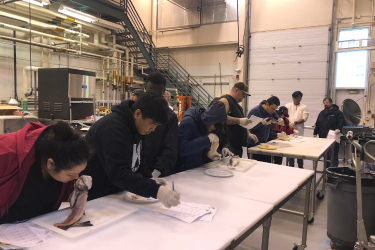Pacific salmon migrations through warmer water
Salmon populations migrate through all major river systems on the West Coast in an ordered sequence. Each population has a characteristic run timing that has evolved over thousands of years to ensure that adults can reach their spawning grounds in time to produce the next generation.
Thus, spring Chinook that spawn in August enter the Columbia River earliest in the spring. Sockeye that spawn two months later enter the mainstem river in July, and steelhead populations, which spawn the following spring, enter rivers from summer through fall.
Each Snake River population has its own adaptation to the thermal regime it generally encounters. Summer steelhead, for example, have plenty of time before spawning and often use cool-water tributaries to avoid high temperatures in the mainstem river.
In contrast, Snake River spring/summer Chinook and sockeye travel directly to their spawning grounds, and delays to migration because of high temperature tend to increase mortality.
relative proportion of selected population groups is shown by arrival day at Bonneville Dam. From the Snake River spring/summer-run Chinook ESU, early-migrating populations (blue) enter the Columbia River in April, followed by later-migrating populations (green), followed by Snake River sockeye (red), Middle Columbia steelhead (white), and Clearwater and Salmon river steelhead (brown) in September and October.
Blue shading shows average daily temperature at Bonnevile Dam. Typically, river temperature is over 18°C from July to October (shown in orange). As temperatures rise due to anthropogenic climate change, periods when temperature exceeds this biologically stressful threshold temperature will increase.
Assuming other factors such as fishing and juvenile transportation are similar to today, we projected salmon survival for the 2040s using temperature projections from global climate models (right panel, see Crozier et al. 2020). Our models allowed the populations to shift their run timing in a plastic response.
Results suggest minimal effects on spring Chinook populations, moderate effects on summer Chinook populations (4-15% declines in survival), and severe impacts on Snake River sockeye (80% declines).
Among endangered populations in the Pacific Northwest, Snake River sockeye is the most sensitive to temperature, especially in the mainstem rivers.
Adults from this population migrate at the warmest time of year through some of the hottest rivers in the region. Declining summer flows exacerbate the risk to Snake River sockeye, especially in the free-flowing Salmon River.
Snake River sockeye is also among the most sensitive populations to climate change because of other human impacts, especially their history of population decline then captive rearing. This history is likely part of why they suffer more from juvenile transportation and higher temperature than other salmon populations.
In the reach from Bonneville to McNary Dam, survival of Snake River sockeye survival is significantly lower than that of upper Columbia River sockeye, even when they encounter the same temperatures.
Climate change is happening faster than average rates of evolution. Still, strong selection on traits with a large genetic component can cause rapid evolution, as we see in various species (Crozier and Hutchings 2014).
Evolution of migration timing
Salmon are exquisite at sensing their environment and modifying their behavior in response. We, therefore, expect many immediate changes in salmon behavior in response to climate change.
However, some populations will need even more adaptation if they are to persist. Salmon vary widely across populations in migration and spawn timing, and these traits are expected to evolve faster than other traits.
Columbia River sockeye has adapted to rising water temperatures by migrating earlier in summer. As shown in the chart, these fish shifted their migration period 11 days earlier from the 1950s (dotted line) to the 2010s (solid line) (Crozier et al. 2011).
We believe this change in behavior was caused in part by plastic responses to flow management, but also by natural selection due to temperature increases over this period. Because later migrants became more likely to encounter lethal temperatures, earlier migrants were more common in subsequent generations.
For populations to evolve like this, they need to be relatively large and heterogeneous. This is one reason why preserving large, diverse, wild populations is vital for natural adaptation to climate change.
References:
Crozier, L. G., J. E. Siegel, L. E. Wiesebron, E. M. Trujillo, B. J. Burke, B. P. Sandford, and D. L. Widener. 2020. Snake River sockeye and Chinook salmon in a changing climate: implications for upstream migration survival during recent extreme and future climates. Plos One 15(9):e0238886. https://doi.org/10.1371/journal.pone.0238886.
Crozier, L. G., M. D. Scheuerell, and R. W. Zabel. 2011. Using time series analysis to characterize evolutionary and plastic responses to environmental change: A case study of a shift toward earlier migration date in sockeye salmon. American Naturalist 178(6):755-773.
Crozier, L. G., and J. A. Hutchings. 2014. Plastic and evolutionary responses to climate change in fish. Evolutionary Applications 7(1):68-87.



